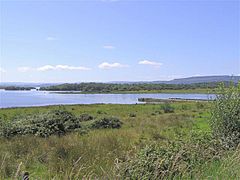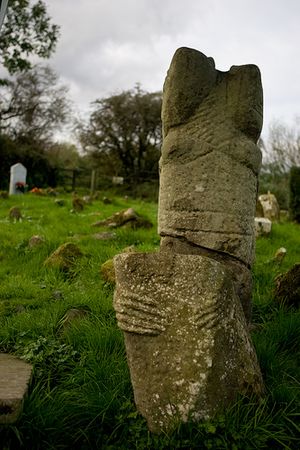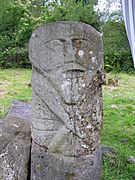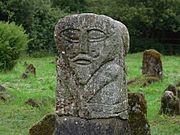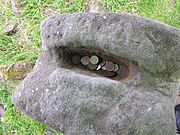Boa Island facts for kids
Boa Island is an island in County Fermanagh, Northern Ireland. It sits near the northern shore of Lower Lough Erne. The island is about 25 kilometers (15.5 miles) from Enniskillen town.
Boa Island is the biggest island in Lough Erne. It is about 8 kilometers (5 miles) long but quite narrow. The A47 road runs along the entire length of the island. This road connects both ends of the island to the mainland using bridges. One bridge goes west towards Castle Caldwell, and the other goes east towards Kesh.
The island has some very old features. These include a ringfort (an ancient circular fort) and a graveyard with carved stones. These old sites are in an area called Dreenan. They are protected as historic monuments. A special stone figure, the Lustymore Island figure, was moved here in 1939. It came from a nearby island called Lustymore. The oldest stone monument on Boa Island is a very old stone mound (called a cairn) near Inishkeeragh Bridge.
Why is it called Boa Island?
Boa Island gets its name from Badhbh. She was a powerful Celtic goddess of war. Sometimes, Badhbh appeared as a carrion crow. She was seen this way on the shoulder of the warrior Cúchulainn after he died in battle. Other times, she looked like a wolf.
Badhbh was part of a group of three Celtic war goddesses. Her sisters were Macha and Morrigan. Their mother was Ernmas, a mother goddess. Ernmas is mentioned in old Irish stories as one of the Tuatha Dé Danann.
People believed Badhbh caused confusion among enemies during battles. This helped her side win. Ancient Celts in Ireland even called battlefields "the land of the Badb."
Mysterious Stone Figures
On Boa Island, you can find two amazing carved stone statues. They are called the Boa Island figure and the Lustymore Island figure. They are located together in Caldragh graveyard. This graveyard dates back to the early Christian period in Ireland (400–800 AD). Both figures were badly damaged when they were first found.
They now stand next to each other on stone pillars in the graveyard. This is where the Boa figure was originally found. These stone figures are believed to be ancient pagan gods or goddesses.
The larger statue is the Boa Island figure. It is considered one of the most mysterious stone figures in Ireland. It is often called a "Janus-figure" because it has two faces. This reminds some people of the Roman god Janus, who also had two faces. However, it is not actually a statue of Janus. It is thought to be a Celtic deity. It could be a goddess or a god, especially given the island's name.
In Celtic culture, heads were very important. People believed a person's spirit lived in their head after death. So, heads were often taken as trophies after battles.
The Boa Island figure is 73 centimeters (28.7 inches) tall. It is 45 centimeters (17.7 inches) wide on its two broader sides. It is 30 centimeters (11.8 inches) wide on its narrow sides. Each side of the figure has a face and a body. Where the two carved figures join, there is a woven design. This might represent hair.
The faces are large and oval-shaped. They have big eyes, straight noses, and half-open mouths with tongues sticking out. The figure has no neck. Its head sits right on its body. The body is a square block with hunched shoulders, crossed arms, and a belt. The figure ends just below its waist. The bottom part of the figure, which shows two hands with long fingers, broke off a long time ago. This broken base was recently found buried near the statue.
There is a deep hole carved into the top of the Boa Island figure. No one knows why it's there. Visitors often put small items like coins in it for good luck. To protect the statue from weather damage, a cover was once placed over it.
The famous poet Seamus Heaney, who won the Nobel Prize, wrote a poem about the Boa Island figure. It was called "January God." Another poet from Enniskillen, Francis Harvey, published a book of poems in 1996 called The Boa Island Janus. Similar statues also appear in the animated movie The Secret of Kells.
The Lustymore Idol was found in an old Christian graveyard on Lustymore Island. This island is south of Boa Island. The Lustymore Idol was moved to Caldragh graveyard on Boa Island in 1939. It stands with its back to the Boa Island figure. It doesn't have as many details on its face, so it looks less impressive. It is about 70 centimeters (27.5 inches) tall. Many people think it is older than the Boa Island figure. It looks more worn out.
We don't know for sure why these stone statues were made or exactly when. They might have been part of pre-Christian religious sites. Or, they might have been made by early Christians who included older pagan beliefs in their grave sites.
The Boa Island figure has been compared to other two-faced statues. One is from Holzgerlingen, Germany. Another is the Tandragee Idol, which is in a collection in St. Patrick's Church of Ireland Cathedral, Armagh.
These comparisons suggest the figure might be from the British Iron Age. However, many similar figures are found around Lough Erne from the early Christian period. For example, the figures on White Island, about 5 kilometers (3 miles) southeast of Boa Island, look simple but are from the early Christian era.
See also
 In Spanish: Isla Boa para niños
In Spanish: Isla Boa para niños


